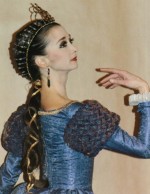Column Name
Title
Subhead
Colorado native Deborah Allton-Maher (BFA ’76, dance) couldn’t have imagined the trajectory her career would take after Juilliard, but when she sat down over the summer with Charles Sheek, Juilliard’s program editor, she said that her position today, as a lawyer and the interim national executive director of the American Guild of Musical Artists (AGMA), has merged every facet of her artistic, professional, and educational experience into a job that she finds relevant, meaningful, and rewarding.
Body
How did you end up at Juilliard?
I was studying ballet in a precollege program at Colorado College and in my junior year in high school spent the summer at the San Francisco Ballet School. They offered me an apprenticeship with the company to begin immediately after graduation, but my parents felt pretty strongly about me going to college instead. I felt that if it had to be college, I wanted the best for dance, and Juilliard stood above the others.
What did you do after graduation?
My first job was at Radio City Music Hall in the corps de ballet. I danced in Basel, Switzerland, and did a tour with William Carter from American Ballet Theatre. During a hiatus from the tour, I auditioned for some fill-in work at the Metropolitan Opera, and they offered me a contract—first as a steady extra, later for the full company. I was there for 19 seasons.
How was it?
It took a while to adjust to the opera world with its big personalities; plus, as a Met dancer you’re not the center of attention like you would be in a ballet company, but part of a much bigger picture. My first major solo, in Verdi’s Macbeth, made for a less-than-stellar debut. I was brand new, and because it was the second run of performances, I only had one stage rehearsal, and it was without lights, a complete set, or costumes—and on a very steeply raked stage. You had to run into the wings and back up to the center at the top of the stage for a quick re-entrance followed by a series of hops on point going downstage. I wasn’t experienced enough to know to walk the stage before the start, so I was unaware that there were now black curtains masking the wings. Everything went fine until I attempted to exit and couldn’t find what in rehearsal was a clearly marked exit but now appeared to be a solid black wall. I was reduced to beating the curtains until I found an opening. When I finally got off stage I was late and tore upstage just in time for the series of hops on point and immediately fell on my face. I never made that mistake again!
My final performance with the Met was the Bacchanale from Saint-Saëns’s Samson et Dalila on tour in Tokyo. Plácido Domingo was Samson, James Levine (Diploma ’63, orchestral conducting) was conducting, and the prime minister was in the audience. It’s a big, over-the-top dance at the finale—the set literally comes crashing down and is always a big crowd-pleaser. It was also the end of the tour and there was confetti and a big celebration, so I pretended it was all for me, since that memorable week also marked my graduation from law school even though I was in Japan, not New York, at the time.
Did your training at Juilliard prepare you for the Met?
It was essential—I felt so facile and prepared for anything. Not just a specific vocabulary in dance but the ability to move in so many different ways and to adapt quickly. At Juilliard you don’t concentrate on just one thing at time, you’re doing everything every day. It’s hard to know how that’s going to translate into your career, but it does.
How did you decide to go to law school?
From the very beginning of my dance career, I wanted to be involved in the conditions of my employment and to make things better, not only for myself but also for my colleagues. At the Met, I put myself into that activity right away. That involved advocacy, contract work, and negotiations with management.
I knew that a dance career was limited and I didn’t want the end of my performing career to be the pinnacle of my professional life, and law school seemed to be the one place where I could put all my life experiences together. It was the hardest thing I ever did. You can’t time this stuff, but it somehow just worked out. Fordham was across the street from Lincoln Center and my schedule allowed for a lot of afternoons to be free with ballets in the latter parts of the operas. I somehow made it to most of my classes from 6 to 9pm and ran back to the Met afterward for performances.
How did you end up at AGMA?
After I graduated from Fordham, I worked for a large law firm, but it felt as if I had amputated an important part of my previous life. During my final season at the Met, I was on the committee involved with negotiations for the next contract and Alan Gordon, then AGMA’s national executive director, said that if I ever wanted a job to call, so before long I did. We represent opera singers, concert singers, dancers, stage production staff, and opera and ballet companies throughout the country, and I’m privileged to work with the most talented and dedicated artists in their fields.
Do you have advice for performers who are faced with job-changing decisions?
To do what you do on a daily basis requires focus, commitment, discipline, patience, perseverance, confidence, faith, compassion, and integrity. When you merge that with your talent, passion, education, and experience, you can’t go wrong.






